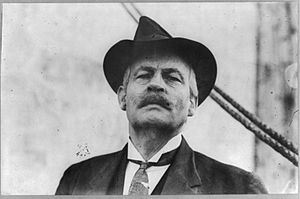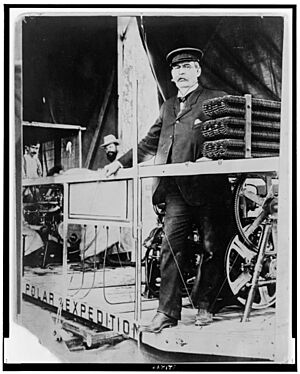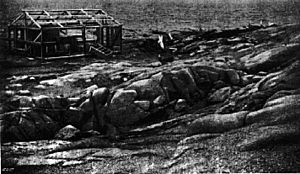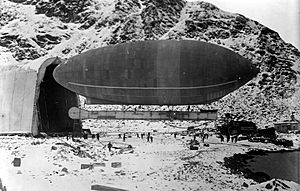Walter Wellman facts for kids
Walter E. Wellman (born November 3, 1858 – died January 31, 1934) was an American journalist, explorer, and airship pilot. He was famous for trying to reach the North Pole and for attempting to cross the Atlantic Ocean in an airship.
Contents
Walter Wellman's Early Life
Walter Wellman was born in Mentor, Ohio, in 1858. His father, Alonzo, fought in the American Civil War for three years when Walter was young. After the war, his family moved west to York County, Nebraska, to become pioneers.
When Walter was just 14, he started his own weekly newspaper in Sutton, Nebraska. At 21, he went back to Ohio and started the Cincinnati Evening Post newspaper. He married Laura McCann in Canton, Ohio, in 1879, and they had five daughters. In 1884, he became a reporter in Washington D.C. for two big newspapers, the Chicago Herald and Record-Herald.
Wellman's First Adventures
Finding Columbus's Landing Spot
The Chicago Herald newspaper asked Wellman to find the exact spot where Christopher Columbus first landed in the Americas. In 1892, Wellman marked the likely spot on San Salvador Island in the Bahamas with a special monument.
Exploring Svalbard
In 1894, Wellman led an expedition to the Arctic. He rented a Norwegian ship called the Ragnvald Jarl and gathered a team of 14 people, mostly from the US and Norway. They sailed north to Svalbard.
Their ship got stuck and sank near Waldenøya. Wellman had to give up his dream of reaching the North Pole that time. Instead, he explored the northeast part of Svalbard, going as far north as 81 degrees. The team was later rescued by another Norwegian ship.
Journey to Franz Josef Land
Wellman tried to reach the North Pole again in 1898. His team included Americans and Norwegians. They sailed from Tromsø to Cape Flora and then set up their main camp, "Harmsworth House," on Hall Island.
One part of the team, led by Evelyn Briggs Baldwin, tried to set up a camp even further north. They faced many challenges, including bad equipment and untrained dogs. They built a hut called "Fort McKinley" on Wilczek Land. Two Norwegians, Paul Bjørvig and Bernt Bentsen, stayed there for the winter with very few supplies. Sadly, Bernt Bentsen became very sick and passed away in January 1899.
Wellman himself broke his leg in March 1899 while trying to go north with sledges. A storm then caused them to lose many dogs and most of their supplies. The Norwegians bravely dragged Wellman back to Harmsworth House on a sledge.
Even with his broken leg, Wellman sent Baldwin and the Norwegians to explore more of Wilczek Land. They discovered Graham Bell Island, which was named after Alexander Graham Bell, the famous inventor. The expedition returned home in July 1899.
Airship Adventures
On December 31, 1905, Wellman announced he would try to reach the North Pole using an airship! His newspaper gave him a lot of money to build an airship in Paris. He set up his base in Svalbard in 1906, but the airship's engines broke during testing.
Wellman rebuilt the airship and tried again in 1907 and 1909, but mechanical problems always forced him to turn back.
In 1910, Wellman made his airship, named America, even bigger. He launched it from Atlantic City, New Jersey, to try and cross the Atlantic Ocean. During this trip, his engineer, Melvin Vaniman, sent one of the very first radio messages from an airship! He famously asked for the launch boat to "come and get" their cat, Kiddo, who wasn't enjoying the flight. After 38 hours, the engine stopped, and the airship drifted until a ship called the Trent rescued them near Bermuda.
A second airship, the Akron, was built the next year. Sadly, the Akron airship had an accident during its first test flight, and the crew of five, including Melvin Vaniman, did not survive. Years later, parts of the airship were found underwater and given to the Smithsonian Institution.
Wellman's Legacy
Walter Wellman wrote several books about his adventures and other topics. These include A Tragedy of the Far North (1902) and The Aerial Age: A Thousand Miles by Airship over the Atlantic Ocean (1911).
He spent his last years in New York City and passed away in 1934. During World War II, a ship called the Walter Wellman was named in his honor.
|
See also
 In Spanish: Walter Wellman para niños
In Spanish: Walter Wellman para niños





